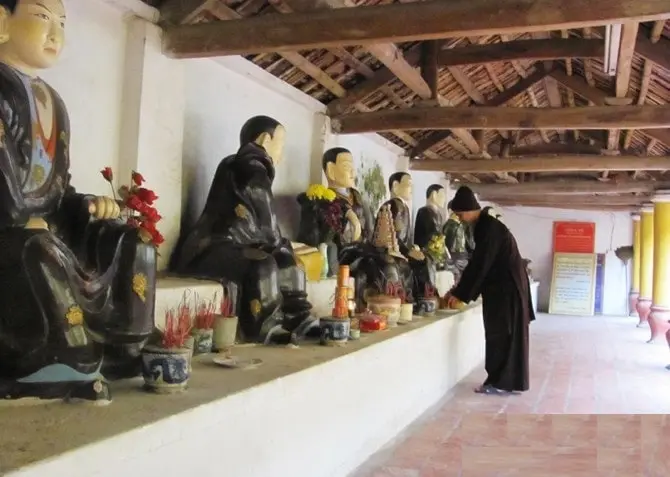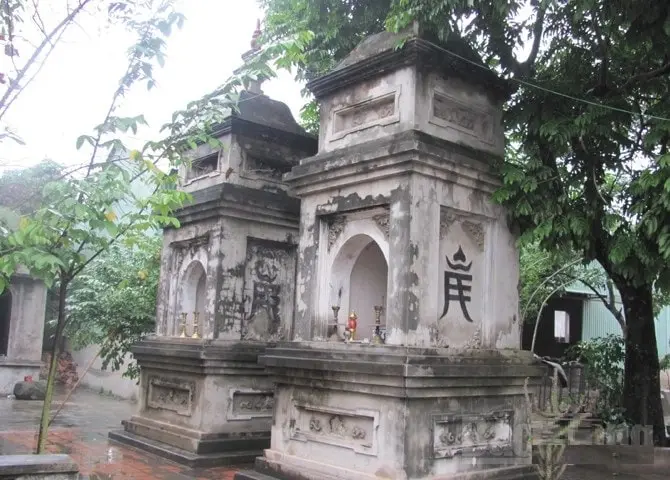1. Where is Painted Temple?
Ve Temple is Huyen Khue, formerly in Nam Xuong commune, Tho Xuong canton, Lang Giang district , now in Tho Xuong ward, Bac Giang city (Bac Giang province) . Ve Pagoda has existed for hundreds of years and is located on a beautiful and open strip of land in the center of Ve village. The pagoda looks to the south, in front there is a large lake, in between are two communal houses, making the temple even more ancient.
2. History of Ve Pagoda
According to historical records, in the great war against the Ming invaders , the Lam Son insurgent army led by Le Loi fought for a long time and defeated Xuong Giang citadel before the reinforcements of the Minh invaders arrived. Although fighting for many days, the force of Lam Son insurgent army was only one third compared to the enemy, but under the direction of Le Loi and the support and help of the people of two villages in the Xuong Giang field, only In one night, he painted a citadel made of rattan, making the Ming invaders extremely afraid, thinking that there was a divine miracle, forcing them to surrender and withdraw their troops back to the country.

To commemorate the merits of the people of the two villages where the old field helped the insurgents paint a fake victory over the Ming invaders , after ascending the throne, King Le Loi named the place where the citadel was painted “Citadel village” and the palace palace. The workers painted the city as “Veu village” and built a temple here.
3. When was Ve Pagoda built?
Based on the inscription on the incense tree “The monument of stone inscriptions of Huyen Khue self” built in the Le Dynasty, dated Vinh Thinh (1705-1719), Ve Pagoda was built in the Le Dynasty , restored many times in the Nguyen Dynasty. At first, the pagoda was still small, later on, monk Giap Linh came here to be the abbot and teach the villagers to contribute money and money, and mobilize donations and visitors from all over the world to build a big temple, then sculpt statues, cast bells…
4. Architecture of Ve Pagoda
The temple is located next to two communal houses (Ca and Chung) creating an ancient feature in the center of Ve village looking to the south. In the minds of the local seniors, the ancient Ve Pagoda is ancient and beautiful, especially since the monk To Giap Linh came here, the abbot has worked with the local people to repair the temple, sculpt statues, and cast bells. Ve Pagoda has the architecture of “Noi Cong, foreign” , including all construction items: Tam Quan, garden campus, Tam Bao building, two corridors, Chung house with match style. Behind the back street is the 5-room Patriarchal church, next to it is the Trai house, the Kinh printing house, the Taoist house, the guest house and below is the Mother shrine.

Through many renovations, at present, Ve village pagoda has basically been restored to its original architectural features. The whole building is more than 5,000 square meters, Tien Duong building has 5 compartments and 2 wings with 4 roofs with roof tiles. The frame for the roof is made of solid wood, the roofs are mounted in the style of a son-in-law, the gong rack is lower than a passerby.
On the wooden structures carved with the pattern of clouds and leaves, the wall behind the Upper Palace is carved with reliefs of the four spirits (dragon, ly, turtle, phoenix) which are airy but simple, showing the tolerance and generosity of the door. Buddha with the ten directions of evidence.
5. The temple has an ancient and beautiful statue in harmony
The worshiping system belongs to the Lam Te Bac Tong line, the Buddha image here is meticulously decorated, sophisticatedly sculpted, after nearly 300 years, it still retains the splendid golden paint color. Ve Pagoda is an ancient temple and has many values in terms of culture , architecture and sculpture . Each statue is a unique work of art by 17th century artisans that have been preserved to this day. It can be said that, besides Vinh Nghiem pagoda in Yen Dung district (Bac Giang), there is no Buddhist temple in this region with ancient and beautiful statues as harmoniously as in Ve Pagoda. In terms of the temple’s artistic value, in 1994 , Ve Pagoda was recognized by the State as a national art relic .

6. A place to store many valuable documents and artifacts
Ve Pagoda also preserves many valuable documents and artifacts, most notably the system of ancient Buddha statues . Each statue is sculpted in a standard and delicate manner, beautifully painted in the color of ripe plums, worthy of a unique work of art in the Le Dynasty. Other documents and artifacts such as incense bowls, wooden muskets, incense burners of the Nguyen Dynasty (nineteenth century), bells of the Tay Son period and especially the stone incense trees of the Le Dynasty, the Vinh Thinh era (1705-1720) … are valuable. cultural and historical value and scientific research value.

7. Ve Temple Festival
Every year, the Ve Pagoda festival is held on January 7 with many rituals and folk games imbued with national cultural identity. Typically, the game pulls the Chinese characters “Thien Ha Thai Binh” or “All people open the festival”… Accordingly, each word is 30 people, 4 letters are arranged at a time, young men and women holding flags, fans, flowers, wearing uniforms as directed by the two chess masters. Sit down and stand up 3 times, toss flowers, chant the letters they are arranged, walk around the field of lettering according to the order of the chess master. Bridge robbery is also a unique game of the Drawing village. This is the belief of agricultural residents who want to pray for the harmony of rain and sunshine and a good harvest.
With unique cultural and architectural values, Ve Pagoda was ranked as a national art relic in 1994. Ve Pagoda is a destination for researchers, students, and a large number of Buddhists. martyrs and tourists from all over the world.
Source: Collected internet.